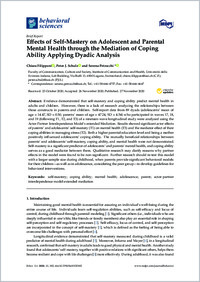Effects of self-mastery on adolescent and parental mental health through the mediation of coping ability applying dyadic analysis
- Filipponi, Chiara Institute of Communication and Health (ICH), Facoltà di comunicazione, cultura e società, Università della Svizzera italiana, Svizzera
- Schulz, Peter J. Institute of Communication and Health (ICH), Facoltà di comunicazione, cultura e società, Università della Svizzera italiana, Svizzera
- Petrocchi, Serena Institute of Communication and Health (ICH), Facoltà di comunicazione, cultura e società, Università della Svizzera italiana, Svizzera
-
27.11.2020
Published in:
- Behavioral sciences. - 2020, vol. 10, no. 12, p. 8 p
Self-mastery
Coping ability
Mental health
Adolescence
Parent
Actor-partner interdependence model extended mediation
English
Evidence demonstrated that self-mastery and coping ability predict mental health in adults and children. However, there is a lack of research analyzing the relationships between those constructs in parents and children. Self-report data from 89 dyads (adolescents’ mean of age = 14.47, SD = 0.50; parents’ mean of age = 47.24, SD = 4.54) who participated in waves 17, 18, and 19 (following T1, T2, and T3) of a nineteen-wave longitudinal study were analyzed using the Actor-Partner Interdependence Model’s extended Mediation. Results showed significant actor effects of parents’ and adolescents’ self-mastery (T1) on mental health (T3) and the mediator effect of their coping abilities in managing stress (T2). Both a higher parental education level and being a mother positively influenced adolescents’ coping ability. The mutually beneficial relationships between parents’ and adolescents’ self-mastery, coping ability, and mental health were not demonstrated. Self-mastery is a significant predictor of adolescents’ and parents’ mental health, and coping ability serves as a good mediator between them. Qualitative research may clarify reasons why partner effects in the model were found to be non-significant. Further research should re-test this model with a larger sample size during childhood, when parents provide significant behavioral models for their children—as well as in adolescence, considering the peer group—to develop guidelines for behavioral interventions.
- Language
-
- English
- Classification
- Medicine
- License
- Open access status
- gold
- Identifiers
-
- RERO DOC 333386
- DOI 10.3390/bs10120182
- ARK ark:/12658/srd1319270
- Persistent URL
- https://n2t.net/ark:/12658/srd1319270
Statistics
Document views: 205
File downloads:
- Fulltext: 249
